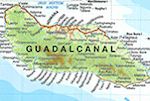Tikitouring
in a fabulous part of the world
WWII
pictures page
Diving
pictures
Saeragi
pictures page
Village
pictures
Gizo
pictures page
Fatboys
Resort
By Richard Moore
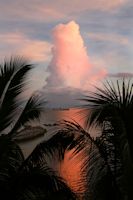 Stepping
off the plane at Honiara’s airport the heat of a Solomon
Islands’ day wraps around you like welcoming arms.
Stepping
off the plane at Honiara’s airport the heat of a Solomon
Islands’ day wraps around you like welcoming arms.
It
pairs well with the warmth of the smiles that meet you,
together with many intonations of “Welkam”, the local
greeting.
It is a nice way to arrive in a relatively unknown part
of the world, one that lies to the east of Papua New
Guinea and is probably best known as the location of
terrible fighting between Allied and Japanese forces
during World
War II.
The
excellent Solomon Airlines flight from Brisbane took
just under three hours and allowed plenty of time to
read over brief notes about the island group.
There
are just under 1000 islands within its boundaries, the
main ones being Choiseul in the far north, the New Georgia
Group in the west, Santa Isobel in the centre, Malaita
and San Cristobal in the east and south and the most
famous of them all Guadalcanal.
Guadalcanal
is a name seared into American minds as a place of bitter
fighting as the Allies launched their first major offensive
against Imperial Japan.
The
campaign lasted six months from August 7, 1942, to February
9, 1943 and cost more than 7000 Allied and 31,000 Japanese
dead.
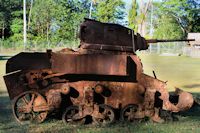 The
islands are a trove of battlefields and war relics and
those interested in military history will find a visit
both fascinating and moving.
The
islands are a trove of battlefields and war relics and
those interested in military history will find a visit
both fascinating and moving.
Honiara
is the main city on Guadalcanal - and the nation's capital
- and people’s opinions of the city are not high.
It
is fair to say we could see why few suggest having a
lengthy stay in the country’s capital. It hasn’t recovered
from the ravaging of catastrophic floods and litter
covers the streets, but the people are polite and quick
to return a smile.
And it does have some nice restaurants, although peak-hour
traffic and wandering pedestrians make for some heart-in-the-mouth
moments.
But
we didn’t come to the island group to stay in a city,
we were there to see the real Solomons – explore some
of the islands where you can get away from it all, have
truly terrific seafood and enjoy some spectacular diving
spots.
Soon after landing in Honiara we went with a knowledgeable
battlefield guide, Michael Ramosaea, to the United States
Memorial high over the city on Skyline Ridge.
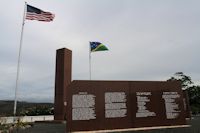 The
Stars and Stripes flies over the carved marble memorial
walls, together with the Solomon Islands flag. The inscriptions
on the walls tell of the bloody battles fought to clear
the islands of the invading Japanese and the high cost
in lives that were claimed on the land, in the air and
on the sea.
The
Stars and Stripes flies over the carved marble memorial
walls, together with the Solomon Islands flag. The inscriptions
on the walls tell of the bloody battles fought to clear
the islands of the invading Japanese and the high cost
in lives that were claimed on the land, in the air and
on the sea.
Following
that we headed about 50km west of the capital to the
Vilu War
Museum.
The
museum building is basic but when you go through to
the outside displays you see what the place is all about.
There
are the remnants of planes, engines and intact Japanese
artillery pieces.
The
Vilu museum is inspiring and visitors making the effort
to see it will not be disappointed.
Our
first regional stopover was Gizo,
a hub town for the western province with a hotel, market
and hospital.
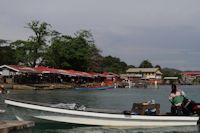 Arriving
by boat you see the red tin roofs of the open market
buildings and crowds of people already there.
Arriving
by boat you see the red tin roofs of the open market
buildings and crowds of people already there.
On
offer are coconuts, root vegetables, cucumbers, chillis
and later in the day, after the fishermen return, fresh
fish.
There are also table after table of betelnuts – a mild
intoxicant much favoured by Solomon Islanders of all
ages and one that when mixed with lime colours the teeth
and mouth red.
The Gizo
hotel is a good place to stay, it has
clean rooms, much needed air-conditioning and a really
good restaurant in which I had the most massive crayfish
for a very paltry sum.
But,
again like Honiara, Gizo is only a short-time base and
we head out on one of the longboats to the village of
Saeragi on the northern tip of Gizo island.
Travelling
by longboat is a common form of travel in the Solomons
and if you like the water then it is a fabulous way
to get about.
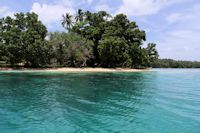 Passing
jungle covered small islands you see a myriad of local
house styles – mostly on poles and made of wood and
thatched palm fronds – and see villagers out in their
boats fishing or going to or from markets.
Passing
jungle covered small islands you see a myriad of local
house styles – mostly on poles and made of wood and
thatched palm fronds – and see villagers out in their
boats fishing or going to or from markets.
Everyone
gives a passing wave – much like truckers signaling
to each other on our highways – then goes back to the
business of the day.
As
we approach Saeragi you can’t help but delight in the
deep green of the waters.
Passing
a headland loads of children wave to us from the sands
and then we are quickly turned towards the golden sands.
A greeting sign is on one of the buildings and as we
prepare to get off the boat we are attacked by half
a dozen men carrying weapons – including a pretty wicked-looking
kindling axe.
They had us cold, but once they’d finished their attack
the war-painted warriors were very helpful getting us
ashore. Multi-talented, you might say.
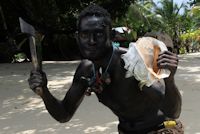 Once
safely on the sands we were welcomed by one of the young
warriors – who was looking much friendlier by the moment
– and he outlined what we would be seeing.
Once
safely on the sands we were welcomed by one of the young
warriors – who was looking much friendlier by the moment
– and he outlined what we would be seeing.
We
saw how they created fire with sticks, husked and scraped
out coconuts and cooked in an above-ground oven.
The
warriors showed dancing skills with three dances and
the one that they would do (hopefully in the past long
past) before setting out on a headhunting trip was actually
quite unsettling.
Then
it was time to enjoy the meal the village prepared for
us – it was very tasty and filling.
Drinks
were straight from young coconuts using rolled-leaf
straws.
It
was a hot day so we thought we would take a bit of a
dip in the warm 28C waters and so joined in with a group
of kids jumping off the beach pier.
At
first they were somewhat surprised but soon splashed
around us.
You
could almost hear them thinking “these are very strange
people.”
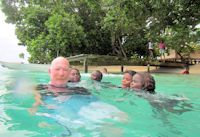 A
couple of examples of mega-bombs from yours truly had
them in fits of laughter and the simplicity of the moments
were among the highlights of the Solomons.
A
couple of examples of mega-bombs from yours truly had
them in fits of laughter and the simplicity of the moments
were among the highlights of the Solomons.
In fact that’s one of the great selling points of the
islands – getting out and meeting local people. They
are really, really cool encounters.
It
could be swimming with kids, popping into a kindy class
in a remote village, chatting with kids while their
mums sell betelnuts or playing soccer while waiting
for a plane.
Memorable
moments that make travel so rewarding.
On
the boat trip back to Gizo we stopped in at Oravae Cottage,
an away-from-it-all place where you can enjoy staying
in comfort on your own little island.
We were treated to lunch there and have to say it is
a perfect getaway spot if you want to leave the world
behind.
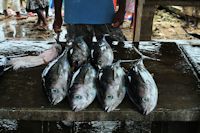 Back
at a sweltering Gizo there was time to turn on the air-conditioner
and drop the temperature to 16C before heading out into
the oppressive heat to visit the fish market.
Back
at a sweltering Gizo there was time to turn on the air-conditioner
and drop the temperature to 16C before heading out into
the oppressive heat to visit the fish market.
On display were masses of yellow-fin tuna caught by
the fishermen in their dugout canoes.
That
night we were treated to an interesting dance night
at the Gizo Hotel as a group of teenagers from one of
the villages entertained us with traditional dance moves
set to to one of the highly rated nearby resorts on
the island of Mbabanga – Fatboys.
Fatboys
is a series of first-class shoreline houses offering
stunning views of the Kolombangara volcano and its restaurant
and bar is at the end of a long pier.
In
fine weather you can snorkel to the place but, unfortunately,
we were there in non-diving waves under grey skies.
In clear blue skies this place would be heaven for tourists.
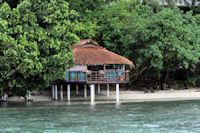 Through
the jungle behind Fatboys we walked to a small village
called Mbabanga where we got a taste of what life was
like for many rural Solomon Islanders.
Through
the jungle behind Fatboys we walked to a small village
called Mbabanga where we got a taste of what life was
like for many rural Solomon Islanders.
It was basic, almost sustenance level, but the people
were wonderful.
We
were greeted by a cute song sung by kindergarten children,
many of whom would not have seen Westerners before.
One kid had to be comforted by his teacher because the
big pink man with the moustache scared him. Ooops, didn’t
mean to.
We
met an elderly woman weaving a beautiful mat out of
palm fibres. The two-tone artwork was for special occasions
– such as weddings – and would take her about a week
to finish. A younger woman looked on, but the old lady
said many did not and the traditional skills were being
lost.
Walking
through jungle areas is exciting and a bit if a sensory
overload.
You
are hearing all sorts of bird calls you have never heard
before, the smell of the rotting vegetation hangs heavily
on the humid air and even in rain you feel the heat
sapping your strength.
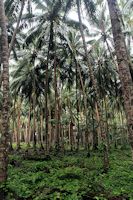 It
makes you admire the soldiers who fought in this area
even more.
It
makes you admire the soldiers who fought in this area
even more.
The
next day we took a boat trip from Fatboys to Munda,
a town we had heard much about.
It
was about an hour away on the southern side of New Georgia.
The
day began reasonably but the weather packed up by the
time we got there and the heavens opened.
Munda
has a great market and some top diving areas, but today
our mission was to check out a couple of WWII-related
sites.
The
first was an impressive collection of war items at the
Peter Joseph Museum. Named after a US soldier whose
dogtags were found, the museum is a fine collection
of helmets, shell casings, machine guns and other war
relics.
It
is the personal project of Barney Paulsen, who is not
only a collector but a war historian as well.
Not far away from the museum is the graveyard of a number
of US landing craft that were cut in half and then bulldozed
off the beach. They now lie hidden in thick jungle and
creepers, their steel towers recognizable among the
greenery.
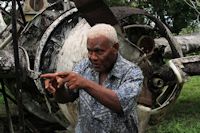 More
WWII treasures await us on the way home.
More
WWII treasures await us on the way home.
We
travel up a tidal inlet on the island of Tahitu in a
bid to find an abandoned tank. The mangroves are eerily
silent and we get our feet wet walking from the boat
to the rising trail that leads into the jungle.
We
are greeted by Hudson, who owns the land on which the
tank is, and we follow him as he slashes the occasional
protruding vine above the foot track.
When we come across the tank it is a beauty. I had been
expecting a little Japanese one, but it turns out to
be a Stuart tank. One of the finest early war models
made and one that would have been perfect for the jungle.
Not too big, but with plenty of firepower.
After
leaving Tahitu we got to snorkel on a sunken Hellcat
within the lagoon. It was down about 10 metres and the
conditions were slightly murky but we could easily make
out its shape.
The
Hellcat had been badly shot up over Rabaul, in New Britain,
but had made its way almost back to base. Eventually
it failed and the US pilot was forced to ditch in the
ocean. He made a good job of it as it is mostly intact
and he survived, which he probably saw as more important.
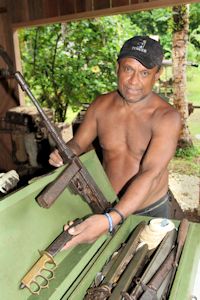 Not
far from Fatboys Resort is what is now known as Kennedy
Island.
Not
far from Fatboys Resort is what is now known as Kennedy
Island.
It
is where John F Kennedy, later president of America,
swam to after his PT109 was sunk by a Japanese destroyer.
The
island sits between the resort and Kolombangara and
you can visit it and even picnic on it.
After a long day on the water we were famished and the
meal at Fatboys was just what the doctor ordered – including
a huge snapper and crayfish in a chilli tomato sauce.
The
food in the Solomons is fresh and varied and is one
of the key advantages it has over many other island
nations.
The next day it’s another early rise and back to Gizo.
We farewell the great staff at Fatboys and turn our
minds to the next destination the Uepi Resort.
Getting
there is a bit of an effort, a half-hour flight in a
small Twin Otter aircraft down to the delightful airstrip
of Seghe, then an hour boat journey to Uepi Island just
off the coast of New Georgia.
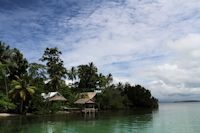 Uepi
Island Resort is fantastic.
Uepi
Island Resort is fantastic.
It is picture-postcard stuff with terrific diving and
snorkeling spots, wonderful accommodation and a very
friendly atmosphere. It is also the perfect place to
get away from it all.
Guests can pretty much do as they like: Sit around and
read, take part in dive trips, snorkel around the small
jetty.
I
would be recommend going snorkeling as the waters are
very clear, the coral and fish colourful, and the waters
warm.
We
got our fins going at the Landoro Gardens, Roma and
then again off the jetty.
It was amazing and other guests who scuba dived were
fair raving about the quality of what they were seeing.
Jill and Grant Kelly are the Uepi Resort owners and
see themselves more as custodians of the island and
it surrounds more than mere owners.
The
resort is eco friendly and they make sure the benefits
of tourism are shared with the local villages in the
lagoon – mainly jobs and helping to educate the children.
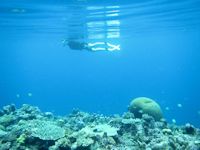 Wandering
around in the heat of the day you can run into large
monitor lizards – striking creatures that come out to
enjoy the sun – or at other times see land crabs moving
about in their many holes that pockmark the walkways.
Wandering
around in the heat of the day you can run into large
monitor lizards – striking creatures that come out to
enjoy the sun – or at other times see land crabs moving
about in their many holes that pockmark the walkways.
We had two-hand-a-half days on Uepi Island and not only
left the most relaxed I have been in years, but also
with quite a bit of regret. It is the sort of place
you could really settle in to and, judging by the 60
per cent re-visit rate by guests – it is not a rare
feeling.
Our boat trip back to Seghe was slightly subdued as
I think we were all sad to leave Uepi.
At
the Seghe aerodrome we met a young family while waiting
for the plane and talked with the girls about school
and what they were studying.
Then
I popped across the grass strip to play a bit of soccer
with some local boys who were taking penalty kicks between
a pole and a block of wood.
Another highlight of the Solomons is being able to chat
to the locals. In the main they speak pijin English,
but many also understand what you are saying.
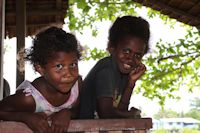 You
pick up so much more on a trip by getting in with them
and the kids are an absolute delight. Big-eyed, wide-grinned
youngsters whose relatively simple lifestyle allows
them to take joy in the basic things. Would that we
all could go back to that.
You
pick up so much more on a trip by getting in with them
and the kids are an absolute delight. Big-eyed, wide-grinned
youngsters whose relatively simple lifestyle allows
them to take joy in the basic things. Would that we
all could go back to that.
Our
last night in Honiara was spent at a very nice Chinese
restaurant where the food was superb.
It
was a very early rise the next morning as we raced to
visit some key World War II sites before flying out.
The
first stop was Hell’s Point, a sealed off area littered
with unexploded ordnance from the war. But, they had
some Japanese tanks and so we snuck in to get some pictures
– only to be yelled at by a rightly grumpy policeman
who asked if we had not seen the massive sign saying
“No Entry.”
I
told him I was a journalist and couldn't read - he didn't
see the funny side.
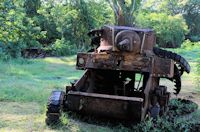 Still,
we got the shots … Then it was on to Alligator Creek,
the site of the battle of Tenaru, where US Marines held
off a huge Japanese attack.
It was a bloody affair with more than 800 Japanese being
killed. The battle features in the first episode of
the TV miniseries The Pacific.
Still,
we got the shots … Then it was on to Alligator Creek,
the site of the battle of Tenaru, where US Marines held
off a huge Japanese attack.
It was a bloody affair with more than 800 Japanese being
killed. The battle features in the first episode of
the TV miniseries The Pacific.
Next
stop wasBeach
Red where the Allied forces first landed on Guadalcanal.
There’s not much to see other than the occasional wire
cord sticking out of the sand.
The
same can’t be said of the nearby Tetere War Museum where
scores of Amtracks – amphibious landing vehicles - are
standing about.
The museum is owned by Samwell Basoe who is a relative
of Sir Jacob Vouza, a local war hero who survived torture
by the Japanese to warn the Americans of the imminent
attack at Alligator Creek.
It
is fascinating looking at the rusting vehicles and many
are being claimed by nature with trees growing out of
them.
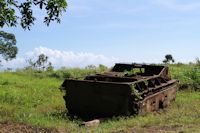 One
thing I learned on the islands is that the guides generally
know what they are talking about and, for military history
buffs, you can pick up a lot of information from a source
very different to the history books.
One
thing I learned on the islands is that the guides generally
know what they are talking about and, for military history
buffs, you can pick up a lot of information from a source
very different to the history books.
If you are after five-star service then the Solomons
are not for you.
There
are few major comforts, litter is a problem and it isn’t
easy getting to places.
However,
if you want to get away from it all, feast on fabulously
fresh seafood, snorkel or dive in stunning lagoons,
come face to face with the remnants of the Pacific War,
meet wonderfully warm people or just try something completely
different then the Solomon Islands is a place you really
should consider.
I
loved the place and my six days there was definitely
not enough.
Another
week would have been about perfect.
To
all the islanders we met I want to say “tank iu to mas”.
Thank you very much.
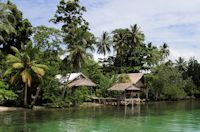
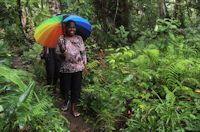
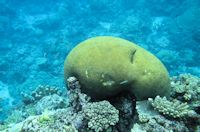
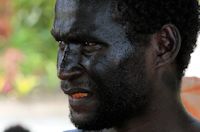

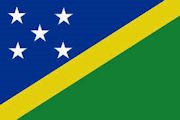
 Stepping
off the plane at Honiara’s airport the heat of a Solomon
Islands’ day wraps around you like welcoming arms.
Stepping
off the plane at Honiara’s airport the heat of a Solomon
Islands’ day wraps around you like welcoming arms.  The
islands are a trove of battlefields and war relics and
those interested in military history will find a visit
both fascinating and moving.
The
islands are a trove of battlefields and war relics and
those interested in military history will find a visit
both fascinating and moving.  The
Stars and Stripes flies over the carved marble memorial
walls, together with the Solomon Islands flag. The inscriptions
on the walls tell of the bloody battles fought to clear
the islands of the invading Japanese and the high cost
in lives that were claimed on the land, in the air and
on the sea.
The
Stars and Stripes flies over the carved marble memorial
walls, together with the Solomon Islands flag. The inscriptions
on the walls tell of the bloody battles fought to clear
the islands of the invading Japanese and the high cost
in lives that were claimed on the land, in the air and
on the sea.  Arriving
by boat you see the red tin roofs of the open market
buildings and crowds of people already there.
Arriving
by boat you see the red tin roofs of the open market
buildings and crowds of people already there.  Passing
jungle covered small islands you see a myriad of local
house styles – mostly on poles and made of wood and
thatched palm fronds – and see villagers out in their
boats fishing or going to or from markets.
Passing
jungle covered small islands you see a myriad of local
house styles – mostly on poles and made of wood and
thatched palm fronds – and see villagers out in their
boats fishing or going to or from markets.  Once
safely on the sands we were welcomed by one of the young
warriors – who was looking much friendlier by the moment
– and he outlined what we would be seeing.
Once
safely on the sands we were welcomed by one of the young
warriors – who was looking much friendlier by the moment
– and he outlined what we would be seeing.  A
couple of examples of mega-bombs from yours truly had
them in fits of laughter and the simplicity of the moments
were among the highlights of the Solomons.
A
couple of examples of mega-bombs from yours truly had
them in fits of laughter and the simplicity of the moments
were among the highlights of the Solomons. Back
at a sweltering Gizo there was time to turn on the air-conditioner
and drop the temperature to 16C before heading out into
the oppressive heat to visit the fish market.
Back
at a sweltering Gizo there was time to turn on the air-conditioner
and drop the temperature to 16C before heading out into
the oppressive heat to visit the fish market. Through
the jungle behind Fatboys we walked to a small village
called Mbabanga where we got a taste of what life was
like for many rural Solomon Islanders.
Through
the jungle behind Fatboys we walked to a small village
called Mbabanga where we got a taste of what life was
like for many rural Solomon Islanders. It
makes you admire the soldiers who fought in this area
even more.
It
makes you admire the soldiers who fought in this area
even more.  More
WWII treasures await us on the way home.
More
WWII treasures await us on the way home.  Not
far from Fatboys Resort is what is now known as Kennedy
Island.
Not
far from Fatboys Resort is what is now known as Kennedy
Island.  Uepi
Island Resort is fantastic.
Uepi
Island Resort is fantastic. Wandering
around in the heat of the day you can run into large
monitor lizards – striking creatures that come out to
enjoy the sun – or at other times see land crabs moving
about in their many holes that pockmark the walkways.
Wandering
around in the heat of the day you can run into large
monitor lizards – striking creatures that come out to
enjoy the sun – or at other times see land crabs moving
about in their many holes that pockmark the walkways. You
pick up so much more on a trip by getting in with them
and the kids are an absolute delight. Big-eyed, wide-grinned
youngsters whose relatively simple lifestyle allows
them to take joy in the basic things. Would that we
all could go back to that.
You
pick up so much more on a trip by getting in with them
and the kids are an absolute delight. Big-eyed, wide-grinned
youngsters whose relatively simple lifestyle allows
them to take joy in the basic things. Would that we
all could go back to that.  Still,
we got the shots … Then it was on to Alligator Creek,
the site of the battle of Tenaru, where US Marines held
off a huge Japanese attack.
It was a bloody affair with more than 800 Japanese being
killed. The battle features in the first episode of
the TV miniseries The Pacific.
Still,
we got the shots … Then it was on to Alligator Creek,
the site of the battle of Tenaru, where US Marines held
off a huge Japanese attack.
It was a bloody affair with more than 800 Japanese being
killed. The battle features in the first episode of
the TV miniseries The Pacific.  One
thing I learned on the islands is that the guides generally
know what they are talking about and, for military history
buffs, you can pick up a lot of information from a source
very different to the history books.
One
thing I learned on the islands is that the guides generally
know what they are talking about and, for military history
buffs, you can pick up a lot of information from a source
very different to the history books.



